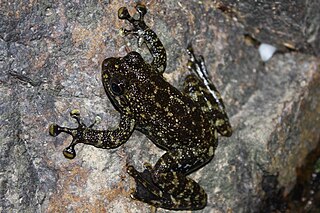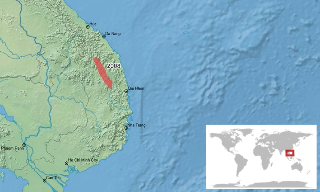
Hong Kong cascade frog or Hong Kong torrent frog is a species of true frog from southern coastal China, once thought to be endemic to Hong Kong. Their eggs are laid on rock faces in the splash zones of cascades. In Hong Kong, it is a protected species under Wild Animals Protection Ordinance Cap 170.

Leptobrachella tuberosa, also known as the granular toad, is a species of frog in the family Megophryidae. As currently known, it is endemic to the Central Highlands of Vietnam in Gia Lai, Quảng Nam, and Thừa Thiên–Huế Provinces. Its true range is probably wider as suitable habitat extends further north and east, reaching northeastern Cambodia and southeastern Laos. The specific name tuberosa is derived from the Latin tuberosus, meaning "full of protuberances".
Amolops cremnobatus is a species of frogs in the family Ranidae. It is found in north-central Laos and Vietnam. Its range might extend into Thailand. The specific name cremnobatus is derived from Greek kremnobates, meaning "frequenter of steep places", and refers to the steep waterfall from which the type series were collected. Common name Lao sucker frog has been coined for it.

Amolops larutensis is a species of frog in the family Ranidae that is found in the Malay Peninsula from southernmost Thailand to Malaysia; records further north probably represent A. panhai.
Huia modiglianii is a species of frog in the family Ranidae. It is endemic to Sumatra (Indonesia). It was originally only known from two locations near Lake Toba, but is now known to be more widespread. The specific name modiglianii honors Elio Modigliani, an Italian anthropologist and zoologist who collected the holotype in 1891. Common name Modigliani's huia frog has been coined for this species. Morphological evidence suggests that it can hybridize with Huia sumatrana, but this needs confirmation using genetic data.

Amolops mengyangensis is a species of frog in the family Ranidae. It is known with certainty only from its type locality, the eponymous Mengyang in Xishuangbanna Dai Autonomous Prefecture, southern Yunnan province of China. However, if Amolops daorum is its junior synonym, distribution of Amolops mengyangensis would be considerably wider, including the vicinity of Sa Pa in northern Vietnam near the Chinese border, Hong Kong, and Houaphanh Province in eastern Laos, and presumably also including the intervening areas. This more inclusive species circumscription was taken in the latest assessment of this species for the IUCN Red List of Threatened Species from 2008.
Meristogenys macrophthalmus is a species of frog in the family Ranidae. It is endemic to Sarawak in northern Borneo (Malaysia) and is only known from its type locality in the Bintulu District. The specific name macrophthalmus is derived from the Greek words macros (="large") and ophthalmos (="eye") and refers to the large eyes of this frog. Common names Matsui's Borneo frog, large-eyed torrent frog, and big-eyed torrent frog have been coined for it.
Meristogenys phaeomerus is a species of frog in the family Ranidae. It is endemic to Borneo and known from central Sarawak (Malaysia) and adjacent Kalimantan (Indonesia). The specific name phaeomerus is derived from the Greek phaios for "dusky" and meros for "thigh", in reference to the appearance of the rear of the thigh. Common names Kapit Borneo frog and Kapit torrent frog have been coined for it.
Amolops daorum is a species of frog in the family Ranidae. It is known from its type locality in the vicinity of Sa Pa in northern Vietnam near the Chinese border, Hong Kong, and Houaphanh Province in eastern Laos; presumably it also occurs the intervening areas. The Hong Kong record is considered suspicious, however. Moreover, some sources, notably the IUCN Red List of Threatened Species, regard this species as a junior synonym of Amolops mengyangensis.
Odorrana jingdongensis is a species of frogs in the family Ranidae. It is known from southern China and northern Vietnam, though it quite likely also occurs in the adjacent areas in Laos and in Myanmar. Its name refers to its type locality, Jingdong Yi Autonomous County in Yunnan. Common name Jingdong frog has been coined for it.
Odorrana junlianensis, also known as the Junlian odorous frog, is a species of frogs in the family Ranidae. It is found in southern China and in the northernmost Laos and Vietnam. Its type locality is the eponymous Junlian County in Sichuan.
Odorrana orba is a species of frog in the family Ranidae. It is found in southeastern Laos and central Vietnam. The specific name orba is Latin for "orphan", referring to the fact that this species was—at the time of species description—known in Vietnam only from a single juvenile.
Philautus abditus is a species of frog in the family Rhacophoridae. It is found in the highlands of central Vietnam as well as in extreme northeastern Cambodia. The specific name abditus is Latin for "hidden" or "concealed" and refers to the black spots on the legs that are concealed while the legs are flexed.
Philautus ingeri is a species of frog in the family Rhacophoridae. It is endemic to northern Borneo and found in Sabah, Sarawak, Brunei, and adjacent northern Kalimantan (Indonesia). Common names Inger's bush frog and Inger's bubble-nest frog have been coined for it. It is named for Robert F. Inger, American zoologist from the Field Museum of Natural History.
Rhacophorus baliogaster, also known as the belly-spotted frog, is a species of frog in the family Rhacophoridae. It is found in the Central Highlands of Vietnam and the Annamite Mountains of adjacent Laos. Its range probably extends into eastern Cambodia where suitable habitat should be present. The specific name baliogaster is derived from the Greek words balios and gaster, meaning "spotted or dappled belly".
Rhacophorus exechopygus is a species of frog in the family Rhacophoridae. It is found in the Central Highlands of Vietnam and in the adjacent Annamite Range in Laos. Its range may extend into northeastern Cambodia where suitable habitat should be present. The specific name exechopygus is derived from the Greek words exechos and pygos (=buttocks), referring to the infra-anal projection characteristic of this frog. Its common names are spinybottom tree frog and Tramlap flying tree frog.
"Hylarana" attigua is a species of frog in the family Ranidae, the "true frogs". The exact genus-level placement of this species is uncertain because it was not included in the revision of the genus Hylarana that saw what was then very broadly defined genus split into several distinct genera, with relatively few remaining in Hylaranasensu stricto. It is found in central and south Vietnam, eastern Cambodia, and southern Laos. The specific name attigua is derived from Latin attiguus meaning "neighbor". It refers to the similarity of this species to Indosylvirana milleti. Common name similar frog has been coined for this species.
Rhacophorus robertingeri is a species of frogs in the family Rhacophoridae endemic to Vietnam. First found in the Annamite Mountains of Vietnam, it is now known from mountain areas between Hà Giang or Nghệ An Province in the north and Gia Lai or Bình Thuận Province in the south, depending on the source. This species can be differentiated from its congeners based on the pointed projection at the tibiotarsal articulation, as well as coloration.
Amolops akhaorum is a species of true frogs discovered in 2007 in the Nam Ha National Protected Area, north-western Laos. It is still only known from its type locality. The specific name akhaorum refers to the local Akha people who helped with the fieldwork of the team who discovered the species.
Quasipaa acanthophora is a species of frogs in the family Dicroglossidae. It is endemic to northern Vietnam and know from two locations, its type locality Mau Son in the Lang Son Province, and the Tay Yen Tu Nature Reserve in the Bac Giang Province. It is a sibling species of Quasipaa spinosa.





